INSTITUT SUPERIEUR D'ANTHROPOLOGIE
INSTITUTE OF ANTHROPOLOGY
ONLINE COURSES / COURS A DISTANCE
WINTER TERM : JANUARY 2016
REGISTER NOW
USA – 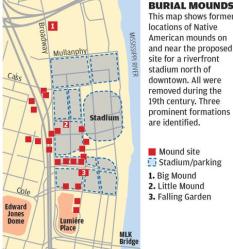
St Louis - One thousand years before there was serious talk of a new football stadium north of downtown, a thriving urban civilization built a network of earthen mounds on the same site. It was scraped away in the careless burst of a second city’s growth during the 19th century. If any evidence survives of that prehistoric Mississippian culture, it’s buried beneath the bumpy streets, scattered businesses, weeded lots and vacant warehouses within the 90-acre site on the riverfront, north of Laclede’s Landing and east of Broadway. Maps and sketches from the early 1800s give locations for at least a dozen mounds within the stadium site, and roughly that many west and north of its fringes. They were similar in form and origin to what survives at the Cahokia Mounds State Historic Site, near Collinsville. Local archaeologists and historians want St. Louis to take time for a serious study of the site before construction begins on any $1 billion stadium and network of parking lots. Andrea Hunter, director of historic preservation for the Osage Nation, said the Osage consider the mound site in St. Louis to be sacred because it was a center of Native American life and was used for rituals and burials. She said the Osage believe they are direct descendants of people who moved into this area from the Ohio valley before the year 1,000, built cities and dispersed mysteriously well before the first European explorers arrived.
http://www.stltoday.com/news/local/govt-and-politics/osage-nation-archaeologists-want-serious-search-for-old-indian-mounds/article_707c6d50-8e38-5b74-b9d0-1d1ecc3f34ce.html
INDE – 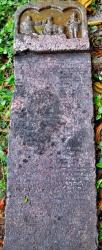 Tiruvottiyur - On the sandy footpath near the Magistrate Court on Apparswamy Street in Tiruvottiyur lies one of the treasures of Old Madras: a four-ft-tall granite pillar with a Tamil inscription. The words inscribed there contain details of donations made by a prominent Shaivite saint to the Kapaleeshwar temple in Mylapore, in the late 19th century. The discovery was made when The Hinduphotographer B. Jothi Ramalingam chanced upon the pillar on the sandy footpath. The front portion of the pillar is damaged and the inscription has corroded partially. “Based on the Saka year mentioned in the inscription, the pillar has been dated May 4, 1892 A.D. It is a legal document of donations made by an individual in those days and should be preserved in a government museum,” said K. Sridharan, retired deputy director of the State Archaeology Department. He de-coded the inscriptions written on the pillar after The Hindusent a few pictures of it to him. Archaeologists and historians say such a granite pillar with ancient Tamil inscription, made by an individual, has been found in the city after many years. The inscription consists of 40 short sentences, which together occupy three-ft space on the pillar. A Shiva Lingam, a Nandi and the pillar’s owner are depicted on the pillar. The shaven head of the owner on the pillar indicates he was a Shaivite saint. The curves on the top of the pillar suggest the influence of Islamic architecture. According to the inscription, Dhatchanamoorthy Swamigal, a well-known Shaivite saint from the region, settled near the Thyagaraja Swamy temple in Tiruvottiyur as a mark of devotion towards Lord Shiva. He donated a garden to the temple in Mylapore, which would be maintained by a person named Rasumudaliyar and his descendents. However, he also said that the property could not be sold or leased by either by Rasumudaliyar or his descendents and belonged to the Shaivite temple. Income earned from donations should be used to feed wanderers and pilgrims at Shaivite temples. Archaeologists said that before Dhatchanamoorthy Swamigal, many other famous Saivaite saints, including Pattinathar, Veeraraghava Swamigal, Appudu Swamigal and Ramalinga Swamigal, spent their last years near the temple in Tiruvottiyur. In fact, the tomb of Tamil saint Pattinathar, from 16th century A.D., is located near the coast in Tiruvottiyur, one of the four Saivaites centres in the city after Mylapore, Padi and Thiruvanmiyur, since ancient times.
Tiruvottiyur - On the sandy footpath near the Magistrate Court on Apparswamy Street in Tiruvottiyur lies one of the treasures of Old Madras: a four-ft-tall granite pillar with a Tamil inscription. The words inscribed there contain details of donations made by a prominent Shaivite saint to the Kapaleeshwar temple in Mylapore, in the late 19th century. The discovery was made when The Hinduphotographer B. Jothi Ramalingam chanced upon the pillar on the sandy footpath. The front portion of the pillar is damaged and the inscription has corroded partially. “Based on the Saka year mentioned in the inscription, the pillar has been dated May 4, 1892 A.D. It is a legal document of donations made by an individual in those days and should be preserved in a government museum,” said K. Sridharan, retired deputy director of the State Archaeology Department. He de-coded the inscriptions written on the pillar after The Hindusent a few pictures of it to him. Archaeologists and historians say such a granite pillar with ancient Tamil inscription, made by an individual, has been found in the city after many years. The inscription consists of 40 short sentences, which together occupy three-ft space on the pillar. A Shiva Lingam, a Nandi and the pillar’s owner are depicted on the pillar. The shaven head of the owner on the pillar indicates he was a Shaivite saint. The curves on the top of the pillar suggest the influence of Islamic architecture. According to the inscription, Dhatchanamoorthy Swamigal, a well-known Shaivite saint from the region, settled near the Thyagaraja Swamy temple in Tiruvottiyur as a mark of devotion towards Lord Shiva. He donated a garden to the temple in Mylapore, which would be maintained by a person named Rasumudaliyar and his descendents. However, he also said that the property could not be sold or leased by either by Rasumudaliyar or his descendents and belonged to the Shaivite temple. Income earned from donations should be used to feed wanderers and pilgrims at Shaivite temples. Archaeologists said that before Dhatchanamoorthy Swamigal, many other famous Saivaite saints, including Pattinathar, Veeraraghava Swamigal, Appudu Swamigal and Ramalinga Swamigal, spent their last years near the temple in Tiruvottiyur. In fact, the tomb of Tamil saint Pattinathar, from 16th century A.D., is located near the coast in Tiruvottiyur, one of the four Saivaites centres in the city after Mylapore, Padi and Thiruvanmiyur, since ancient times.
http://www.thehindu.com/news/cities/chennai/pillar-with-tamil-inscription-found/article7745101.ece
USA –  Newport Harbor - A team of marine archaeologists, scientists and volunteers continued their methodical work mapping shipwrecks in Newport Harbor last month in an ongoing effort to find and positively identify Capt. Cook’s famous vessel, the HM Bark Endeavor. Eighteenth Century British Explorer Capt. James Cook explored more of the world than any man who ever lived and many researchers believe the Endeavor, his most-famous vessel, is among a fleet of 13 British transport ships sunk during the Revolutionary War in Newport Harbor. When the vessel is believed to have been sunk in 1778, it by then had changed hands and was known as The Lord Sandwich. During a five day fieldwork exercise in September, members of the Rhode Island Marine Archaeology Project and the Australian National Maritime Museum mapped the ninth shipwreck site and completed a pre-disturbance site map of an 18th century ballast pile. To find the Endeavor, researchers must find and map all the 18th century shipwreck sites that still exist in Newport Harbor and “only then will the detailed work begin that may identify which site is which ship,” said Dr. Kathy Abbass, RIMAP director. The most-recently mapped site was found in the fall of 2014 and “now that we have mapped it,” Abbass said, “we have nine ships of the thirteen in our database. Although it will take many years to prove it, we now have a 69 percent change that we have already located the Lord Sandwich ex. Endeavor.”
Newport Harbor - A team of marine archaeologists, scientists and volunteers continued their methodical work mapping shipwrecks in Newport Harbor last month in an ongoing effort to find and positively identify Capt. Cook’s famous vessel, the HM Bark Endeavor. Eighteenth Century British Explorer Capt. James Cook explored more of the world than any man who ever lived and many researchers believe the Endeavor, his most-famous vessel, is among a fleet of 13 British transport ships sunk during the Revolutionary War in Newport Harbor. When the vessel is believed to have been sunk in 1778, it by then had changed hands and was known as The Lord Sandwich. During a five day fieldwork exercise in September, members of the Rhode Island Marine Archaeology Project and the Australian National Maritime Museum mapped the ninth shipwreck site and completed a pre-disturbance site map of an 18th century ballast pile. To find the Endeavor, researchers must find and map all the 18th century shipwreck sites that still exist in Newport Harbor and “only then will the detailed work begin that may identify which site is which ship,” said Dr. Kathy Abbass, RIMAP director. The most-recently mapped site was found in the fall of 2014 and “now that we have mapped it,” Abbass said, “we have nine ships of the thirteen in our database. Although it will take many years to prove it, we now have a 69 percent change that we have already located the Lord Sandwich ex. Endeavor.”
http://patch.com/rhode-island/newport/search-capt-cooks-shipwrecked-endeavor-continues-newport-harbor-0
FRANCE – 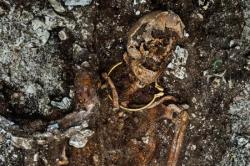 Lavau - Les archéologues en sont maintenant pratiquement certains. « À 94 % », affirment Bastien Dubuis et Émilie Millet. Le personnage aristocratique inhumé au V e siècle avant notre ère dans une tombe à char, à Lavau, est un homme. C’est ce qu’ont prouvé des examens plus poussés de son squelette. Exhumé en fin de fouilles, le personnage laissait planer un mystère. « Le mauvais état de conservation des ossements ne permet pas encore de déterminer avec certitude le sexe de l’individu. » Si la carrure était masculine, la parure était marquée d’indices tendant vers l’hypothèse d’une femme.
Lavau - Les archéologues en sont maintenant pratiquement certains. « À 94 % », affirment Bastien Dubuis et Émilie Millet. Le personnage aristocratique inhumé au V e siècle avant notre ère dans une tombe à char, à Lavau, est un homme. C’est ce qu’ont prouvé des examens plus poussés de son squelette. Exhumé en fin de fouilles, le personnage laissait planer un mystère. « Le mauvais état de conservation des ossements ne permet pas encore de déterminer avec certitude le sexe de l’individu. » Si la carrure était masculine, la parure était marquée d’indices tendant vers l’hypothèse d’une femme.
http://www.lest-eclair.fr/357410/article/2015-10-09/decouverte-archeologique-a-lavau-c-est-un-prince
IRAN –  Arastou - Arastou Hill in Malard Township, Alborz province, can uncover secrets about the lifestyle of the first permanent settlements in Iran, said Alireza Vakili, the head of Malard Cultural Heritage Department. The official said many historical objects have been unearthed during the recent phase of excavation. "Iron Age potteries, food warehouse, and skeletons dating back to over 5,000 years have been discovered in the region, which are testimonies to the age-old history of permanent settlements in Iran," he said. Hamed Zargar, an archeologist, said Arastou Hill was first settled during the Neolithic Era. "The hill has been settled during various eras including the Copper and Bronze Ages. The expert said the discovery of remains of a mill in the region suggests that ancient settlers of Arasou Hill were involved in the industry. "Houses of Arastou Hill have a unique architecture. Similar architecture has been discovered in the Azarbaijan region (in northwest) and central plateau of Iran," he said.
Arastou - Arastou Hill in Malard Township, Alborz province, can uncover secrets about the lifestyle of the first permanent settlements in Iran, said Alireza Vakili, the head of Malard Cultural Heritage Department. The official said many historical objects have been unearthed during the recent phase of excavation. "Iron Age potteries, food warehouse, and skeletons dating back to over 5,000 years have been discovered in the region, which are testimonies to the age-old history of permanent settlements in Iran," he said. Hamed Zargar, an archeologist, said Arastou Hill was first settled during the Neolithic Era. "The hill has been settled during various eras including the Copper and Bronze Ages. The expert said the discovery of remains of a mill in the region suggests that ancient settlers of Arasou Hill were involved in the industry. "Houses of Arastou Hill have a unique architecture. Similar architecture has been discovered in the Azarbaijan region (in northwest) and central plateau of Iran," he said.
http://www.iran-daily.com/News/128713.html?
Bulgarie – 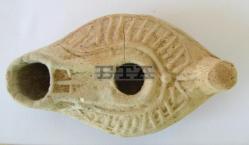 Abritus - Archaeological structures, consisting of ruins of dwellings from the Early Middle Ages were discovered during excavations at the Abritus archaeological site, near the town of Razgrad. The recent finds were discovered by archaeologists from the Razgrad Regional Museum of History during exploration activities in the area where Abritus was located in Late Antiquity, head of excavations Galena Radoslavova told BTA. Her crew's work is funded by the Bulgarian Ministry of Culture and Razgrad Municipality. According to the archaeologist there are several interesting finds from this period, including a set of pectoral crosses (enkoplions) with the Crucifixion of Jesus depicted on the one side and the Virgin Mary on the other. The discovered dwellings can be linked to the Bulgarian population's settlement on the ancient ruins between the end of the 9th and the beginning of the 10th Century, said Radoslavova. The archaeologist believes that the newly-discovered archaeological artefacts, which include numerous ceramic dishes, bowls, cups, amphoras, lamps and parts of glass vessels, have suffered a severe fire. Radoslavova believes that the finds and the bronze coins discovered date from a period between the middle of the 4th and the end of the 5th Century.
Abritus - Archaeological structures, consisting of ruins of dwellings from the Early Middle Ages were discovered during excavations at the Abritus archaeological site, near the town of Razgrad. The recent finds were discovered by archaeologists from the Razgrad Regional Museum of History during exploration activities in the area where Abritus was located in Late Antiquity, head of excavations Galena Radoslavova told BTA. Her crew's work is funded by the Bulgarian Ministry of Culture and Razgrad Municipality. According to the archaeologist there are several interesting finds from this period, including a set of pectoral crosses (enkoplions) with the Crucifixion of Jesus depicted on the one side and the Virgin Mary on the other. The discovered dwellings can be linked to the Bulgarian population's settlement on the ancient ruins between the end of the 9th and the beginning of the 10th Century, said Radoslavova. The archaeologist believes that the newly-discovered archaeological artefacts, which include numerous ceramic dishes, bowls, cups, amphoras, lamps and parts of glass vessels, have suffered a severe fire. Radoslavova believes that the finds and the bronze coins discovered date from a period between the middle of the 4th and the end of the 5th Century.
http://www.bta.bg/en/c/NW/id/1183307?
JAPON – 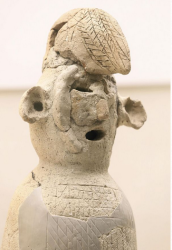 Sawara Ward - A haniwa clay figure unearthed from the Haizuka tomb in Sawara Ward, Fukuoka, has been restored and is on display for the first time in Nara Prefecture. The Haizuka tomb is a large, keyhole-shaped mound created at the end of the fourth century. The approximately 70-centimeter-tall figure is a tatemochi, or shield-holding warrior, discovered in an excavation in 1988-89. At that time it was thought to be one of the oldest haniwas in the shape of a human. The figure is cylindrical from the neck down, with a shield rendered in lines on the front. It also has a unique head with what looks like a pompadour hairstyle, the museum found. When the haniwa was excavated, a piece of armor about 15 centimeters deep, 10 centimeters wide and 10 centimeters tall was found alongside it. Archaeologists originally thought the object was an archer’s left-wrist protector, used when shooting arrows.
Sawara Ward - A haniwa clay figure unearthed from the Haizuka tomb in Sawara Ward, Fukuoka, has been restored and is on display for the first time in Nara Prefecture. The Haizuka tomb is a large, keyhole-shaped mound created at the end of the fourth century. The approximately 70-centimeter-tall figure is a tatemochi, or shield-holding warrior, discovered in an excavation in 1988-89. At that time it was thought to be one of the oldest haniwas in the shape of a human. The figure is cylindrical from the neck down, with a shield rendered in lines on the front. It also has a unique head with what looks like a pompadour hairstyle, the museum found. When the haniwa was excavated, a piece of armor about 15 centimeters deep, 10 centimeters wide and 10 centimeters tall was found alongside it. Archaeologists originally thought the object was an archer’s left-wrist protector, used when shooting arrows.
http://the-japan-news.com/news/article/0002484541?
SOUDAN – 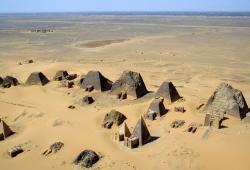 Nubie - Sure, we’ve all heard of Egypt’s pyramids, but have you heard of Sudan’s pyramids? Well, you really should have – they’ve survived in the African desert for 3,000 years, and they’re absolutely spectacular, as we can all see, thanks to this National Geographic drone footage. These pyramids were built by Nubians, the rulers of the ancient Kushite kingdoms. The Kushites were an ancient African kingdom situated in today’s Sudan. Approximately 255 pyramids were constructed over a period of a few hundred years to serve as tombs for the kings and queens of the area, though they are much smaller than the Egyptian ones. All of the pyramid tombs of Nubia were plundered in ancient times and all of the jewelry and valuable possessions were stolen; however, archaeologists have discovered bows, quivers of arrows, archers’ thumb rings, horse harnesses, wooden boxes, furniture, pottery, colored glass, metal vessels, and many other artifacts which helped them date and frame the pyramids into a historical context. But we still have much to learn about them, and this footage definitely helps: “The best part with the helicopter is I can fly over and gain this connection between all the other burial sites, between the pyramid and the temple, and get an understanding of what that is from the air,” National Geographic Society engineer and drone pilot, Alan Turchik, explains in the video above.
Nubie - Sure, we’ve all heard of Egypt’s pyramids, but have you heard of Sudan’s pyramids? Well, you really should have – they’ve survived in the African desert for 3,000 years, and they’re absolutely spectacular, as we can all see, thanks to this National Geographic drone footage. These pyramids were built by Nubians, the rulers of the ancient Kushite kingdoms. The Kushites were an ancient African kingdom situated in today’s Sudan. Approximately 255 pyramids were constructed over a period of a few hundred years to serve as tombs for the kings and queens of the area, though they are much smaller than the Egyptian ones. All of the pyramid tombs of Nubia were plundered in ancient times and all of the jewelry and valuable possessions were stolen; however, archaeologists have discovered bows, quivers of arrows, archers’ thumb rings, horse harnesses, wooden boxes, furniture, pottery, colored glass, metal vessels, and many other artifacts which helped them date and frame the pyramids into a historical context. But we still have much to learn about them, and this footage definitely helps: “The best part with the helicopter is I can fly over and gain this connection between all the other burial sites, between the pyramid and the temple, and get an understanding of what that is from the air,” National Geographic Society engineer and drone pilot, Alan Turchik, explains in the video above.
https://www.youtube.com/watch?v=O7tAuPi_azU
http://www.zmescience.com/science/archaeology/sudan-pyramids-nubian-06102015/